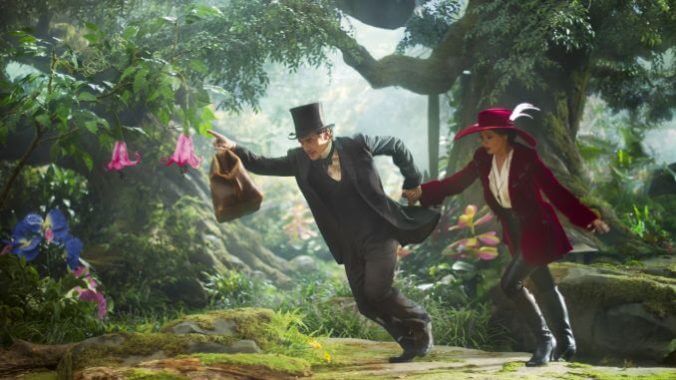Oz the Great and Powerful Reminds Us of the Worst Oz Has to Offer

When I pressed play on the used Blu-ray of Oz the Great and Powerful that the record store was all too happy to give away, two trailers rolled before the menu. The first was Gore Verbinski’s desiccated Lone Ranger adaptation; the second was for ABC’s Once Upon a Time mecha-meta-series. All three titles share one crucial thing in common: They are Disney branding itself onto nostalgic properties of the American cultural landscape.
But while the two trailers are for properties that Disney owns outright or through its subsidiaries, Oz the Great and Powerful exists in a swirling tornado of copyright and public domain. According to the behind-the-scenes documentary “Walt Disney and the Road to Oz” included on the home release, Disney had wanted to tell his version of the Oz story since the studio began. But when MGM dropped a house on his plans and snagged the rights to L. Frank Baum’s first Oz book in the 1930s, Walt could only wait. Though he later bought the rights to the later Oz serials and half-produced the flimflam Mouseketeer special “The Rainbow Road to Oz” in 1957, the iconic images inscribed onto the American cultural landscape—especially the ruby slippers and the green Wicked Witch—permanently belong to MGM as their proprietary additions to the story. When The Walt Disney Company tried to fulfill Walt’s unrealized dream with Return to Oz (1985), they had to pay the rival studio for the rights to ruby slippers. Sam Raimi’s Oz the Great and Powerful was to be wholly unique to Disney, the culmination of a vision “worthy of the wizard himself.”
Yet, released ten years ago, the film only continued Disney’s tradition of unsuccessful Oz-ventures. Oz the Great and Powerful was released to a general shrug from critics and audiences alike and today remains the outlier in Raimi’s otherwise celebrated oeuvre. The collective rejection of Oz the Great and Powerful is more exciting than the film: It protests the enclosure of a commonly held cultural landscape. As of the mid-1990s, the Oz works written by L. Frank Baum between 1900 and 1920 exist in the public domain. Oz belongs to us.
If the lesson of The Wizard of Oz is “there’s no place like home,” then the moral of Disney/Raimi’s story is “there’s no place like Oz.” More than anything, Oz the Great and Powerful is about how extraordinary the land is, how vivid its splendor is, yet how untamed and in need of order. As such, the most successful elements of Oz the Great and Powerful are Raimi’s practical realizations of the wonderland. His insistence that they build as much of the world as possible gives the film the little magic it possesses.
“Oz is here,” Mila Kunis shares with us in “Before Your Very Eyes – From Kansas to Oz,” a mini-doc about the film’s production design. Raimi’s keen sense of fantasy was correct to steer him to practical sets and effects. Teaming with Oscar-winning production designer Robert Stromberg (Avatar, Burton’s Alice in Wonderland), Raimi does what he does best, mixing old and new cinematic techniques. The hand-built sets and puppets give a nice tangibility and texture to the world of Oz and bring it to life for us. Even more impressively, they bring James Franco to life. Where The Wizard of Oz (1939) and The Wiz (1978) used matte paintings to fill in the rest of the territory, blue screen technology now digitally renders the horizon.
Sadly some of this work is cluttered by studio-mandated 3D, which stretches disbelief into silliness. But as the lead architect of Pandora and Disney’s idea of Wonderland, Stromberg is exceptionally versed in domesticating imaginative worlds. Not only are these worlds visually similar, they share narrative similarities. They chronicle the mythic arrival of a white underdog who inherits the supernatural territory and eccentric citizens as their “rightful” or “noble” guardians. Like Avatar especially, Raimi’s Oz has much to do with land, enclosure and removal, which are also the keys to understanding our lack of enjoyment.
-

-

-

-

-

-

-

-

-

-

-

-

-

-

-

-

-

-

-

-

-

-

-

-

-

-

-

-

-

-

-

-

-

-

-

-

-

-

-

-








































